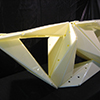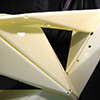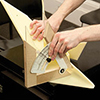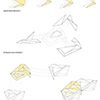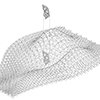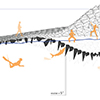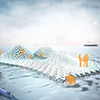The Aquatic Research Platform is a floating observatory that controls human interaction with marine life. The cellular mesh forms a porous surface where aperture size controls engagement with the water. The areas that rise above the surface of the water contain larger apertures that allow users to pass through the net-like platform and engage with marine life. The submerged areas of the platform contain smaller apertures to provide a smoother walking surface and a protective barrier between human inhabitants and the more dangerous aquatic life forms. To provide for a smooth walking and climbing surface that is appropriate to this type of marine application, the folded panels conceal all hardware connections within the interior of the connective geometry between cells.The initial analogue studies focused on the generation of a cellular network formed from minimal cutting and folding. The base geometry was created with triangular cells formed from three simple panels. Each panel contains only three folds and fastens to adjacent panels to form a triangular cell with a central aperture. The geometry of the folded mesh is generated by several parametric definitions in Grasshopper where the opening and closing of the triangular aperture responds to the human-to-marine life interface desired. Distance based attractors are used to control the opening and closing of the apertures as well as the overall depth of the cellular construct.
© 2013 MARK POTHIER
